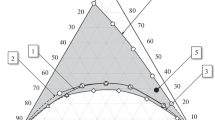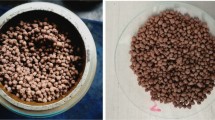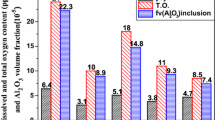A large amount of oily cuttings is produced in the drilling process when the oil-based drilling fluid is used. The oil and oil-soluble additives adsorbed on the surface of the cuttings may pollute the environment. In this paper the method of silicic acid precipitation and formation of silicic acid micromicelles is used to encapsulate oil and to remove oil from the cuttings. The authors analyze the influence of the stirring time and the solution pH on the oil removal efficiency. When the pH is 2 and the stirring time is 10 min, the oil removal rate is 96%. Research into the mechanism shows the successive formation of silicic acid sol and gel in the process of silicic acid precipitation. The structure of the silicic acid micromicelles is characterized by scanning electron microscopy (SEA). The results of differential scanning calorimetry (DSC) indicate the existence of the exothermic decomposition peak of the hydrocarbons in the range from 350°C to 500°C, which proves that the micromicelle inner phase contains oil.
Similar content being viewed by others
Avoid common mistakes on your manuscript.
1. INTRODUCTION
In the drilling process, the oil-based drilling fluid has been widely used in complex well drilling, such as deep well drilling, drilling in high temperature and high pressure conditions, and drilling in water-sensitive strata. The oil-based drilling fluids are characterized by good performance with respect to antipollution, lubricity and rejection characteristics to maintain stability of the borehole wall [1,2,3,4,5]. The oily cuttings generated by the oil-based drilling fluid in the drilling process should not be discharged directly to the environment. For instance, the zero discharge requirement has been implemented in Norway. Correspondingly, the discharge limit for the North Sea (non-Norwegian sector) and UK. CS is set to 1%. The Gulf of Mexico and South American CS currently permit 6.9%, in case of a synthetic oil used in the fluid [6,7,8,9].
The oily cuttings disposal technologies include reinjection, burning, distillation, cleaning, centrifugation, supercritical CO2 extraction, microwave heating, solvent extraction, and biological degradation [10,11,12,13]. All methods have their strengths and weaknesses, and their application is determined by the processing costs and relevant technological conditions. The suggested oil removal method is based on chemical and physical properties of silicates to form silicic acid micromicelles, encapsulating the oil phase. The method has shown good performance in comparison with other methods mentioned above.
Carbonate rock, which accounts for about one-fifth to a quarter of the total sedimentary rock, is well known for its rich oil reserves. Carbonate rock oil and gas fields constitute about 50% of total reserves in the world and show enormous potential for the petroleum industry [14,15,16,17]. In this paper, we used carbonate rock and 04 diesel as samples of oily cuttings. OP-10 and sodium dodecyl benzene sulfonate were used as emulsifiers, and silicic acid was used to form micromicelles. We analyzed the mechanism and factors influencing the formation of the silicic acid micromicelles. The results can provide help and reference for subsequent studies.
2. EXPERIMENTAL PART
2.1. Materials
In the experiment, the main experimental apparatus includes the scanning electron microscope, the laser particle size analyzer (Mastersizer 2000), the differential scanning calorimeter, and the ultraviolet and visible spectrophotometer (11V-1700). Experimental compounds were supplied by ChengDu Belong Chemical Co., Ltd., including carbonate rock samples (100 mesh), OP-10, sodium dodecyl benzene sulfonate, hydrochloric acid, petroleum ether, and the 0# diesel.
2.2. Experiments
2.2.1. Preparation of samples.
Carbonate rock was crashed to particles of size ranging from 50 to 100 mesh. The selected carbonate rock particles were mixed in the beaker with the 0# diesel and treated under stirring for 30 min. The sample material was then kept sealed in the glassware.
2.2.2. Determination of the standard curve.
The 0# diesel solutions were mixed with the petroleum ether to prepare solutions with concentrations of 1, 5, 10, 15, 20, 30. and 50 mg/L. The solutions were transferred into 10 mm quartz curettes. The maximum wavelength was measured by the ultraviolet-visible spectrophotometer, with the petroleum ether acting as a reference solution. When the maximum wavelength point was determined, the corresponding oil absorbance values were measured, and then the standard curve was obtained.
2.2.3. The experiment of oil removal by silicic acid micromicelle.
The compound degreaser CYJ was prepared by mixing OP-10, sodium dodecyl benzene sulfonate and hydrochloric acid at a certain mass ratio. The sample material was mixed with distilled water (500 mL), and then the CYJ was added. After stirring for 10 minutes, a measured amount of sodium silicate was added to the solution. After solid-liquid separation, the filtrate was mixed with an appropriate amount of the petroleum ether and then extracted. The liquid phase separation was performed using a separatory funnel. The oil fraction after extracting was transferred to the volumetric flasks (50 mL) The oil sample (1 mL) was then transferred into the measuring cylinder (100 mL) and diluted with the petroleum ether to a volume of 80 mL The resulting solution was inserted into a quartz cuvette (10 mm) for the absorbance value measurement, with petroleum ether used as the reference solution. The quantity of residual oil was evaluated by comparing the absorbance value with the standard curve. Then the sample cuttings were mixed with the distilled water, and then petroleum ether extraction was repeatedly performed. After the extraction, the absorbance of the diluted oil sample was measured. The original oil content was evaluated by comparison with the standard curve. The oil removal rate was then calculated based on the quantity of original and residual oil quantity [18].
2.2.4. Characterization of the silicic acid micromicelle.
The micromicelle parameters were analyzed by scanning electron microscopy (SEM), laser particle analysis and differential scanning calorimetry (DSC).
The scanning electron microscopy
In scanning electron microscopy the electron beam is used to scan the surface of the sample. The surface structure of the sample must be well preserved, dried, and have good electrical conductivity. The initial sample processing includes cleaning, fixation, dehydration, desiccation, and conductive treatment.
The laser particle size analyzer (Mastersizer 2000)
The sample is evenly dispersed by mechanical stirring and subsequent high-frequency ultrasonic oscillation. The circulating pump makes particles evenly distributed in the circulation system.
The test operation is as follows. The dispersion medium with the tested sample is transferred to the device. The ultrasonic generator and the circulating pump help to provide the even distribution of particles in the medium. The test results are displayed in the form of particle size distribution data tables, distribution curve, and specific surface area curve.
Differential scanning calorimeter
The DSC method results in a scanning curve of the heat quantity, depending on temperature (or time), in comparison with the reference sample. The exothermic peak on the DSC curve helps to identify the main constituent of the silicic acid micromicelle.
3. RESULTS AND DISCUSSION
3.1. Factors influencing the oil removal rate
3.1.1. Influence of pH on oil removal rate.
The absorbance of the diluted residual oil was measured by the ultraviolet-visible spectrophotometer at room temperature when the pH was respectively adjusted to 1,2,3,4, and 5. Then the oil removal rate was calculated. The results are shown in Fig. 1.
As can be seen in Fig.1, the oil removal rate was 96.21% when the pH was 2. When sodium silicate is added to the solution, silicate ions react with hydrogen ions in the solution, resulting in silicic acid precipitation. During stirring, the silicic acid precipitate is adsorbed on the surface of the emulsified oil drops, forming micromicelles. When the pH is higher than 2, the lack of hydrogen ions in the solution leads to the formation of silicic acid colloidal sol, causing instability of the micromicelle structure. When the pH is lower than 2, the number of silicic acid micromicelle structures is markedly smaller. The reason is that the silicic acid excess leads to a higher probability of the smaller silicic acid particles bumping into each other, forming the silicic acid precipitate.
3.1.2. Influence of stirring time on oil removal rate.
The pH was adjusted to 2. The sample material was mixed with the compound degreaser solution CYJ, and stirring was kept for 2, 4, 6, 8, 10, and 12 min. Then the absorbance of the diluted residual oil was measured by the ultraviolet-visible spectrophotometer at room temperature. The calculated oil removal rates are shown in Fig. 2.
As can be seen in Fig. 2, when the stirring time is 10 min, the oil removal rate is up to 96%. When the stirring time is less than 10 min, the stirring and emulsification is not sufficient, and the smaller number of oil-water structures leads to a lower oil removal rate. A stirring time longer than 10 min leads to the destruction of the emulsifier film and, consequently, to demulsification of the system .
3.2. The mechanism of oil removal by silicic acid micromicelle
3.2.1. The forming process of a silicic acid microcapsule.
Silicic acid is a dibasic weak acid (K1=2x10-10 K2=1x 10-12), with acidity smaller than that of carbonic acid. Silicic acid precipitate occurs when a strong acid is added to a soluble silicate solution. The formation of the silicic acid is a complex reaction. At the first stage, orthosilicic acid (H4SiO4) is generated, which then forms a silicic acid colloidal sol. When the colloidal sol concentration is high enough, silicic gel is formed. The related reaction equations are as follows:
The silicic acid formation was not observed at the beginning of our experiment, as the monomolecular orthosilicic acid H4SiO4 produced at the first stage of the reaction is soluble in water. In due time the orthosilicic acid (H4SiO4) dehydrates, forming silicic acid H2SiO3, dimeric silicic acid (H2SiO3)2, trimeric silicic acid (H2SiO3)3, and even multimeric silicic acid (H2SiO3)., which are poorly soluble in water. The silicic acid H2SiO3molecules are adsorbed on the surface of the emulsified oil drops, resulting in the formation of the silicic acid micromicelle. The process is schematically shown in Fig. 3.
3.2.2. Characterization of the structure of the silicic acid micromicelle
3.2.2.1. Scanning electron microscopy (SEM).
The micromorphology of the silicic acid micromicelle sample was analyzed by the scanning electron microscope (SEM) method, with 10,000 magnification power. The results are shown in Fig. 4.
Fig. 4. SEM micromorphology of the silicic acid micromicelles.
As can be seen in Fig. 4, the silicic acid micromicelle is characterized by a transparent shell layer and a darker core layer. The majority of oil drops are encapsulated inside the silicic acid agglomerates in the form of micelles, with a small number of silicic acid micromicelles distributed in the dispersion medium. The reason is that the silicic acid particles are able to bond, forming the silica acid gel. The larger micellar particles settle under the gravity force and separate from the aqueous phase. The oil drop average diameter is about 1 ím.
3.2.2.2. Laser particle size analysis.
The silicic acid micromicelle particle size and distribution were analyzed by the laser particle size analyzer (Mastersizer 2000). Samples of silicic acid micromicelles, evenly dispersed in water, were prepared by the wet dispersion method. The results are shown in Fig. 5.
As can be seen in Fig. 5, the silicic acid micromicelle particle sizes range between 10 and 100 pm, which also proves the existence of the silicic acid agglomerates in the process of forming the silicic acid micromicelles. The difference in particle sizes is probably caused by the uneven dispersion of oil drops in the medium. Another reason lies in the difficulty of controlling effectively the stage of encapsulating the oil drops by the silicic acid molecules. The particle sizes obviously depend on the stirring parameters.
3.2.2.3. Differential scanning calorimetry analysis.
The existence of the oil phase encapsulated inside the silicic acid micromicelles is indicated by the exothermic peak on the DSC curve. The spectrogram of the silicic acid micromicelles is compared with the pure silicic acid spectrogram. The results are shown in Figures 6 and 7.
As can be seen in Figures 6 and 7, the obvious decomposition exothermic peak proves that the micromicelle inner phase contains oil.
4. CONCLUSIONS
-
1.
In this paper we examined the mechanism of formation of the silicic acid micromicelles and its application for oil removing treatment of the oily cuttings. Under acid conditions, silicic acid molecules encapsulate the emulsified oil drops forming the latex-group structure of the silicic acid micromicelle, which was demonstrated by SEM. The differential scanning calorimetry (DSC) results indicated that the silicic acid micromicelle inner phase contains oil.
-
2.
Further research showed that the stability of the silicic acid micromicelles depended on the acidity of the medium. The lack of hydrogen ions in the solution leads to the partial formation of the silicic acid colloidal so I. Moreover, the efficiency of emulsification depends on the stirring time. As was shown, when the pH was 2 and the stirring time was 10 min, the oil removal rate by the silicic acid micromicelle formation was as high as 96%.
References
J. A. Veil, J. of Energy Rasour. Technol., 125, 238-248 (2003).
A. Ramadan et al., J. Pet. Sci. Eng., 30, 129-141 (2001).
R. D. Rufino et al., J. Pet. Sci. Eng., 109, 117-122 (2013).
Xiaodong Bai et al., J. Appl. Polym. Sci., 132, No. 14, 27-34 (2015).
V. P. Sokolov et al., Chem. Technol. Fuels Oils, 15, No. 4, 295-298 (1979).
F.V. Jones and A. J. J. Leuterman, Alternate Environmental Testing of Drilling Fluids: An International Perspective, SPE European Petroleum Conference. The Hague, Netherlands, 21-24 October, 1990.
D. P. J. Morrish et al., Drilling Fluids: Economics and Planning to Achieve Environmental Targets, SPE Health, Safety and Environment in Oil and Gas Exploration and Production Conference. Jakarta, Indonesia, 25-27 January, 1994.
A. K. Wojtanowicz, Environmental Control Potential of Drilling Engineering: An Oveniew of Existing Technologies, SPE/IADC Drilling Conference. Amsterdam, Netherlands, 11-14 March, 1991.
Yan Jienian and Zhao Xionghu, Rheological properties of oil-based drilling fluids at high temperature and high pressure, Acta Pet. Sin., 24, No. 3, 104-109 (2003).
Li Xueqing et al., The harmless treatment technique of oily cuttings on oil-based drilling fluid (in China], Drill. Fluid Completion Fluid, 30, No. 4, 81-83 (2013).
J. P. Robinson et al., Chem. Eng. 152, 458-463 (2009).
C. G. Street and S.E. Guigard. J. Can. Pet. Technol., 48, No. 6, 26-29 (2009).
R. H. Adams, Environ. Asia, 4, No. 2, 33-37 (2011).
G.A.M. Shaw and B. Slater, Removing Oil from Drill Cuttings - An Offshore Solution. SPE Offshore Europe Conference, Aberdeen, United Kingdom, 5-8 September, 1989.
N.P. Thurman and M.T. Heydeman, A Microbial Approach to Cleaning Used Oil Based Drilling Muds, SPE Offshore Europe Conference, Aberdeen, United Kingdom, 3-6 September, 1991.
Xiaodong Bai et al., J. of Appl. Polym. Sci., 134, No. 46, 1-9 (2017).
Zhouyang Lian et al., Chem. Technol. Fuels Oils, 50, No. 6, 501-507 (2015).
Li Qiuhong et al., Research on technology of oil removal from oily waste water, Sci. Technol. Chem. Ind., 16, No. 5, 24-28 (2008).Fig.6. Scanning calorimetry curve of silicic acid microraicelle.
Acknowledgement
This paper was supported by the National Natural Science Foundation of China (NSFC), within the project “Dispersion process and mechanism of multi-component nanoparticles in drilling fluids” (serial number 51104122).
Author information
Authors and Affiliations
Corresponding author
Additional information
Translated from Khimiya i Tekhnologiya Topliv i Masel, No. 5, pp. 57-61, September — October, 2019.
Rights and permissions
About this article
Cite this article
Bai, X., Zhang, X., Ning, T. et al. Oil Removal Technology and the Mechanism of Oily Cuttings by Silicic Acid Micromicelles. Chem Technol Fuels Oils 55, 590–598 (2019). https://doi.org/10.1007/s10553-019-01071-z
Published:
Issue Date:
DOI: https://doi.org/10.1007/s10553-019-01071-z











